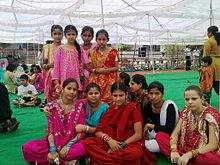Meghwal

A group of Megh girls at Kabir Jayanti function in Jammu, India
|
|
| Regions with significant populations | |
|---|---|
| • India • Pakistan | |
| Religion | |
| •Hinduism |
The Meghwal (or Megh, Meghwar) people live primarily in northwest India, with a small population in Pakistan. They were considered to be an untouchable community under the Hindu ritual ranking system known as varna and are now classified as a Scheduled Caste under India's system of positive discrimination. Their traditional occupation was weaving. Most are Hindu by religion, with Rishi Megh, Kabir, Ram Devji and Bankar Mataji their chief gods.
The Meghwal community is known by various names, depending on location. Examples include Megh and Menghvar.
They claim to have descended from Rishi Megh, a saint who had the power to bring rain from the clouds through his prayer. The word Meghwar is derived from the Sanskrit words megh, meaning clouds and rain, and war (Hindi: वार), meaning a group, son and child. (Sanskrit: वार:) Literally, then, the words Meghwal and Meghwar connote a people who belong to Megh lineage.
Some Meghwals are associated with other social groups. Shyam Lal Rawat refers to the Meghwals of Rajasthan as "one of the dominating low untouchable castes ... earlier known as Chamars", and the Balali and Bunkar communities have also begun using the Meghwal name.
The Meghwal are found in Gujarat, Madhya Pradesh, Maharashtra and Rajasthan. The Meghs, Kabir Panthi or Bhagat are from Himachal Pradesh and known as Megh, Arya Megh and Bhagat. In some places they are known as Ganeshia, Meghbansi, Mihagh, Rakhesar, Rakhia, Rikhia, Rishia and other names. Some of the Mahashas also claim to be belonging to Meghs. After Partition of India in 1947, the Meghs who had become converts to the Hinduism, had to migrate to Indian territory.
...
Wikipedia
